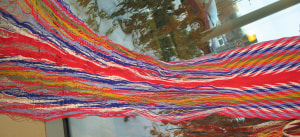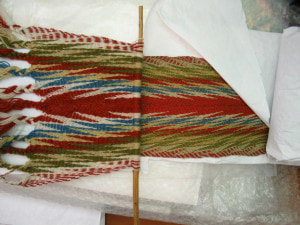|
The fingerweaving method tends to create a tangle of threads at the lower margins of the work. This is commonly called the ‘false weave’, and a person can spend many hours per sash periodically untangling this mass.
Occasionaly people have said to me, “Too bad you can’t use that somehow.” I have spent some time thinking about this. My work with sprang teaches me that it is possible. Indeed, sprang was done alongside fingerweaving in certain parts of Quebec in the 18oo’s. Whenever I travel anymore I try to scout out as many examples of sashes as possible along the way. I’ve met with some success requesting permission to examine sashes and record data. Over the past few years I have come upon some spectacular fingerwoven sashes, and five very loosely woven ones. The loose ones intrigue me. How does a person weave that loosely and at the same time keep it even. I have some experience dealing with the ‘false weave’, creating ‘art pieces’ which incorporating it as part of the work. More recently I have conducted experiments, working with the false weave. Working on a 12 ft sash, I sat myself on a high chair and pushed the false weave as far down, close to the floor as possible. Using this method I’ve been able to pack as many as five repeat patterns before untangling. It seems that, if you start out with the threads knotted together to keep them even, that a mirror image of the sash pattern is created. a mirror image pattern can be seen in the falseweave At one point I took my weaving to the Manitoba Museum and compared the false weave with a loosely woven sash there. They matched up quite nicely. Travelling last Summer, I examined sashes in Edmonton, Alberta, and found three that my data would declare to be in the loosely woven category: fine thread comparable to 2/8 worsted wool, and fewer than 7 threads per inch lengthwise. The sash of a local hero, Elzéar Goulet, is preserved in the Musée de St Boniface Museum, a few blocks from my home. It is an example of such a loosely woven sash. There is interest in a reproduction of the Goulet sash, and I am intrigued to explore a technique that would yield such a loose weave. Last Fall, I made a successful proposal to the Manitoba Arts Council for a Craft Grant. Subsequent to receiving approval I have proceeded to match yarn and dyestuffs to the original. Last week I made up a sample to verify my success at matching the colors. The curator snapped a photo of my sample alongside the original. sash color comparison You will notice that my sample, the one on the left, is wider than the original. The next step is for me to re-spin the yarn, eliminating its ‘fuzziness’ and compacting it down. My calculations indicate that this final step will allow me to make a very close copy of the original. The respinning will occupy me (along with a few other projects, like the local Winter carnival, Festival du Voyageur) for the month of February. In early March I will measure out an extra long warp. I will then set myself to weaving a sash. The false weave I will push, row by row, to the far end of the warp. If all goes as expected, I will weave two sashes at once, one a nice tightly woven sash, and one the falseweave, packed into a replica of the Elzéar Goulet sash. I’ll keep you posted.
0 Comments
Your comment will be posted after it is approved.
Leave a Reply. |
Categories
All
Archives
May 2023
Categories
All
|


 RSS Feed
RSS Feed